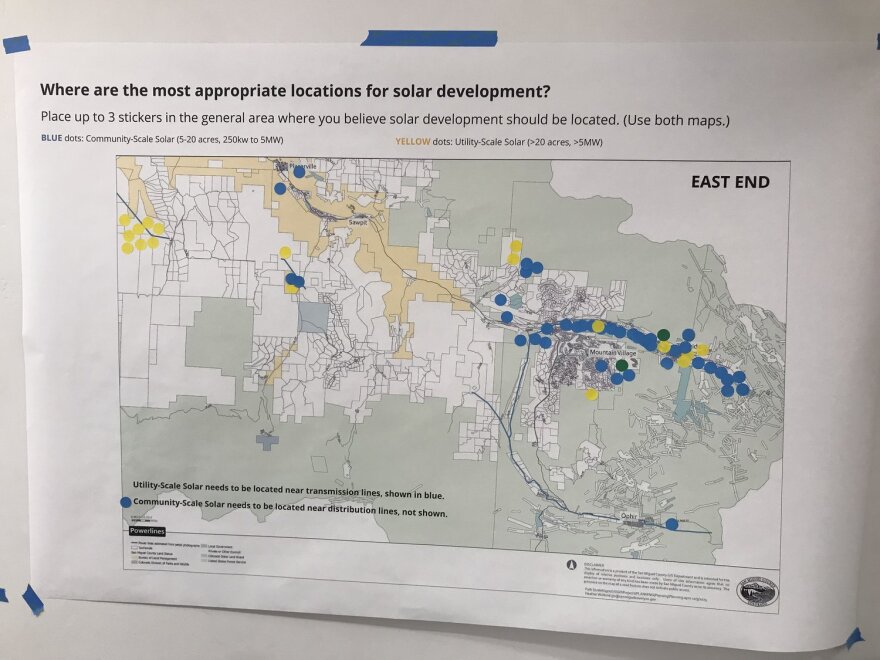Drivers traveling west on Colorado Highway 145 across Wrights Mesa and into Norwood are greeted at the edge of town with a homespun billboard hanging on a fence — it pictures a goat and huge block text reading “Wrong Mesa Solar.”
The billboard has stood there all summer and is a response to the Wright's Mesa Solar Project — a 600 acre solar development proposed by OneEnergy Renewables on Lone Cone Road just outside of Norwood.
When the project was introduced at a public meeting in mid-May, community members turned out in droves to voice their opposition to the project. The level of concern was so intense that San Miguel County issued a 6 month moratorium on all new commercial scale utility applications — including solar ones — in order to update its land use code.
That passed on May 24, recalls County Planning Director Kaye Simonson
“We put the moratorium into place. We’re not going to be done in time for that moratorium but we can extend it. It will be up to the Board of County Commissioners obviously to do that, but we do expect to extend it because we won’t have [the revisions] ready in time,” said Simonson.
I spoke with Simonson at a county open house held this week at the Lone Cone Library in Norwood to gather public input on possible land use code edits. The room was filled with infographics and maps, as well as invitations for public comment to be written on sticky notes and placed around the room.
Turnout was high for the two-hour open house.
“People have some very — they’re very passionate about it. And they have a lot of ideas and a lot of thoughts and we’re trying to get them all put together,” said Simonson.
While the land use code updates are county-wide, east to west end, and not only focused on solar, but also other utility development, mining, logging, natural resources, and so forth — conversation centers around the Wright's Solar Development.
Charmaine Toomey remains shocked by the plan brought forth by OneEnergy Renewables
“I’m for solar, especially on individual homes and barns. As far as giant complexes in neighborhoods? Where they’re cutting down trees, ruining the habitat, ruining our water? It’s just not right to put a complex, an industrial complex, in a neighborhood,” Toomey says.
The land use code currently has no specific regulations around commercial-scale solar development, and Terry Lammers — whose family ranch is located on Lone Cone Road — says the county must prepare.
Federal and state renewable energy goals will make large-solar projects a common occurrence.
“I think we’re just beginning to see the tip of the iceberg,” said Lammers.
Wendy Brooks is a resident of Telluride, but has family land in Norwood. She opposes the Wright's Mesa Solar Project, and feels the issue has a specific east county — west county divide.
“I think a lot of people in Norwood are suspicious that somehow it’s going to happen to them because all the county powers are in Telluride,” she said.
Brooks points to a map of San Miguel County hanging on the wall. It invites participants to put a sticker where they think solar development should go.
“The most common place listed is the Valley Floor of Telluride. I mean there are 27 out of 40 that are all on the Valley Floor,” she said.

For Brooks, all those stickers on the Valley Floor — which is a conserved piece of land and barred from solar development — points to a feeling amongst Norwood residents of a double standard, where Telluride’s open spaces are considered precious and unassailable, while land on Norwood’s Mesa is regarded as common, disposable.
But for others, such as Ophir resident Kim Wheels, the whole conversation was a disturbing illustration of how difficult the green energy transition will actually be.
“We have climate action plans: a regional CAP, a Telluride CAP, a Mountain Village CAP, Norwood is part of this, Ophir is part of this, all of our regions are. And yet putting feet to the ground, and what it actually looks like to implement it, is a complete flip, and difficult,” she said.
The county has pledged a 90% reduction in greenhouse gases over 2010 levels by 2050. But as Wheels points out, how those goals will be implemented and where the infrastructure will go remains an enormous question, especially as the county looks to renew the moratorium for another six months.
This story from KOTO was shared via Rocky Mountain Community Radio, a network of public media stations in Colorado, Wyoming, Utah and New Mexico including Aspen Public Radio.


